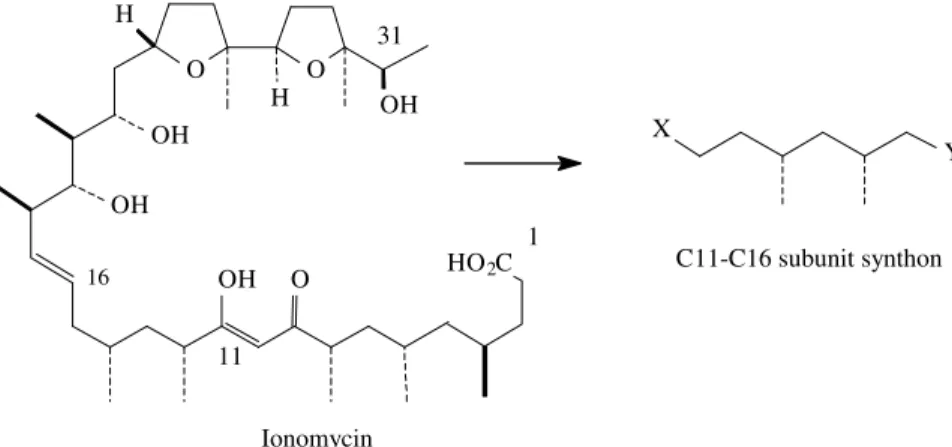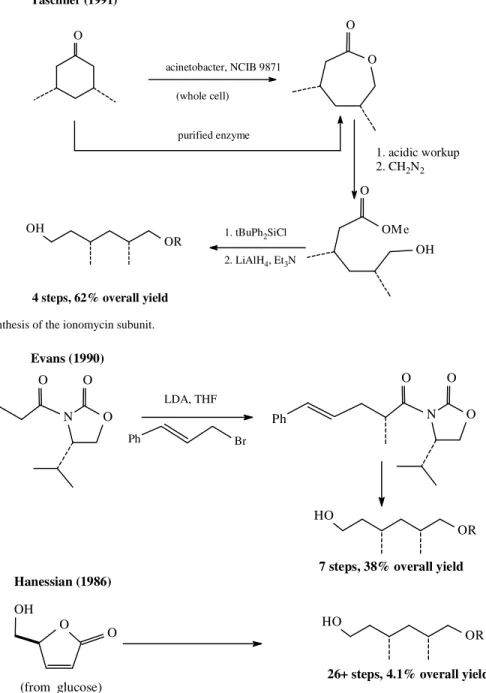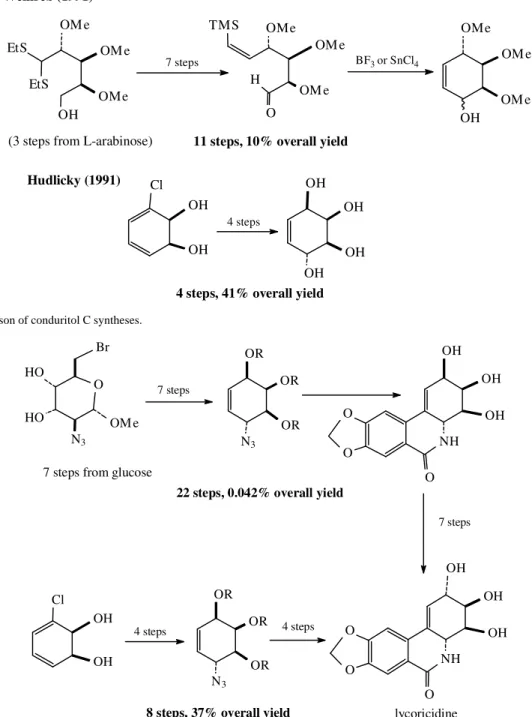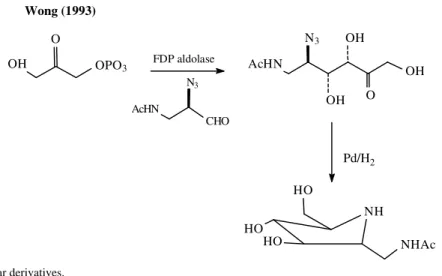Natural Product Synthesis via Biocatalysis: An Essay on the Merits
of Multidisciplinary Ventures
Tomas Hudlicky
Chemistry Department, University of Florida, Gainesville, FL 32611, USA
Received: August 10, 1998
Apresenta-se uma opinião crítica a respeito dos méritos de atividades multidisciplinares con-tendo uma certa dose de ousadia, em química orgânica sintética. Em particular, o conceito de ‘‘caixa-de-ferramentas’’ das metodologias disponíveis para a solução eficaz de problemas em síntese orgânica é analisado no contexto de exempolos disponíveis na literatura, assim como a partir e projetos de pesquisas em andamento em nosso grupo de pesquisas. A discussão de diversos casos de sínteses totais realizadas recentemente oferece evidências de que a introdução de métodos biocatalíticos melhora significativamente o processo global de preparação das substâncias alvo de uma síntese. Alguns exemplos desses projetos fomam igualmente o tópico da plenária deste autor no 8° Encontro Brasileiro de Síntese Orgânica em Setembro de 1998.
A critical opinion is advanced on the merits of multidisciplinary ventures in synthetic organic chemistry. In particular, the concept of a ‘‘tool box’’ of methodologies available for effective solutions to problems in organic synthesis is analyzed in the context of available examples from the literature as well as from the ongoing projects in our research group. The discussion of several cases of recently accomplished total syntheses offers evidence that the introduction of biocatalytic methods greatly improves the overall process of preparation of target compounds. Some examples of such projects form also the topic of the authors lecture at the 8th Brazilian Meeting on Organic Synthesis in September 1998.
Keywords: biocatalysis, natural synthesis
Introduction
The total synthesis of natural products enjoyed fast growth during the 1960’s and the 1970’s, perhaps at the expense of more basic disciplines such as physical organic chemistry and methodology-oriented synthetic organic chemistry. In the 1980’s the emphasis returned to develop-mental organic chemistry. The reasons for such a paradigm shift are not entirely clear but there are several possible explanation: first, the trust in the synthetic community has been eroded because the promises of ‘‘practical solutions to the supply problem of therapeutically useful agents’’ have not materialized and no naturally occuring compound has been made by total synthesis in a manner competitive with isolation or fermentation methods. Second, the academic community shifted its emphasis to more methods-oriented investigations with focus on highly specific reagent-based solutions to uniquely defined problems in reaction devel-opment. Third, the community of synthetic chemists
re-acted to critique from a defensive standpoint and instead of broadening its repertoir of methods for problem solving it focused even more narrowly on ‘‘classical’’ solutions to reaction control. It would therefore appear that the modern organic chemists have regressed rather than advanced in their pursuit of important problems in synthesis. The focus today is almost entirely on specific applications of reagents or reactions with a high degree of ‘‘local’’ control (i.e., diastereoselectivity) but of little use (as a concept) for wider audiences.
Some views supporting the above observations have already been recorded in the printed forum1-5. The accom-plishments provided by modern synthetic ventures have been reviewed on a number of occasions with different conclusions. Certainly it would appear that organic synthe-sis is not a mature discipline, nor is it one in which the success of prediction of events approaches that of their explanation after the fact. Organic synthesis, unlike physics
or engineering, is not built on irrefutable laws and depends to a great extent on serendipity, intuition, and observation. It is also clear that excursions beyond the traditional disci-pline of one’s training bring about a great improvement in the problem solving process. Examples of such improve-ments are visible in the merging of inorganic and organic chemistry for catalyst development, molecular modeling in structure-activity research, and the combination of biology and chemistry for understanding the mode of action of drugs. What has not yet taken place is a fully accepted merger of biology and synthetic organic chemistry, al-though fermentation or partial fermentation approaches to target compounds are a way of life in the pharmaceutical industry. The academic community, certainly in the U.S. more so than in Europe, has been reluctant to accept the discipline of biocatalysis and continues to emphasize the traditional approaches to reaction control, which do not (and cannot) lead to efficient preparation of target com-pounds. The examples provided in this article should serve to convince the reader that biocatalytic synthesis offers unparallelled advantages over classical methods.
Discussion
Nature does not use many reactions or even many elements to control the outcome of a particular synthesis in the living systems. Metabolic processes rely instead on the precise definition of the environment in which a very simple reaction takes place (i.e., ‘‘substrate control’’). The proteins that have evolved to recognize chemical sub-stances for further functionalization do so with remarkable specificity and efficiency, unmatched by modern chemical methods. Their effectiveness stems entirely from control-ling the orientation of the substrate (steric control) and not from recognizing the nature of the group to be transformed (electronic control). This point seems to be lost on the present-day organic chemist who frequently attempts ex-actly the opposite approach in the design of new reagents or catalysts.
The mechanisms of many enzymatic reactions are rela-tively well understood, and there is ample technique avail-able in molecular biology to express and even alter the function of many enzymes. Today the organic chemist should view these proteins simply as reagents for certain transformations to be incorporated into the planned path-way. It is remarkable how few academic groups (especially within the U.S.) have been open-minded to such combina-tions of disciplines. The following examples from the lit-erature illustrate what happens to the overall effectiveness of a synthesis upon incorporating a single enzymatic step into the sequence of events.
A striking example of the increased efficiency that results when a new technology is incorporated into syn-thetic undertaking is seen in three approaches to the C11-C16 subunit of ionomycin, Fig. 1. The synthesis of this subunit requires a solution to one of the classical problems in synthesis-controlling of stereochemistry at saturated centers on an acyclic framework. Taschner has recognized, quite brilliantly, that the relationship of the two methyl substituents corresponds to the cis-stereochemistry found in a cyclic meso ketone which may undergo enzymatic desymmetrization through the Baeyer-Villiger reaction6. Here, the use of either whole-cell fermentation or the isolated and purified enzyme (with the necessary cofactor recycling loop incorporated into the transformation) leads in four steps to the required synthon in an excellent overall yield, as shown in Fig. 2. By comparison, the classical approaches used by Evans7 and Hanessian8, shown in Fig. 3, use many more steps to either establish (Evans) or manipulate (Hanessian) chirality at the onset of the synthe-sis. It is clear that the combination of the enzymatic step with standard chemical procedures yields a far more effi-cient (and, by definition, also less costly) preparation of the target compound.
On the other hand, one may argue that the purpose of the acadamician is to train new personnel, and thus the longer the synthesis, the more reactions the student can learn. Nevertheless, the training must also teach a realistic
OH
OH O
OH
O O
H OH
H
HO2C
X
Y 31
1
16
11
Ionomycin
C11-C16 subunit synthon
view of the undertaking, its overall cost, permanent or even current value to society, and, above all, common sense. Unfortunately, many programs completely ignore the latter aspects of training and the result is a narrowly focused and ineffective delivery of the targets in insufficient amounts. Seldom does the academic community subject lengthy total syntheses to the ultimate test of reproducibility of both the preparation and the values of the reported yields. Only
Organic Synthesis requires checking of the procedures by
independent laboratories; other journals simply publish the results, validated by editors and referees who do not often question the authors’ yield values even though they may
find them unusually high. The ‘‘yield inflation’’ has emerged as a problem in the last twenty years or so and its continuous practice further detracts from the respect of synthesis in those instances where the reported products may have a real value in society2.
In some instances, the pursuit of a ‘‘new methodol-ogy’’justifies the total synthesis, as in the example of a conduritol C synthesis, shown in Fig. 4. In Weinreb’s approach, a vinyl silane-aldehyde cyclization is tested as means of carbon-carbon bond formation9. The pursuit of such methodology is, of course, noble, provided it results in a permanent enhancement of current technology. Here, O
O O
OM e O
OH OH
OR Taschner (1991)
acinetobacter, NCIB 9871
(whole cell)
purified enzyme
1. acidic workup 2. CH2N2
1. tBuPh2SiCl
2. LiAlH4, Et3N
4 steps, 62% overall yield
Figure 2. Taschners synthesis of the ionomycin subunit.
O N
O O
O O
N O
Ph
Ph Br
O O OH
HO
OR
OR HO
Evans (1990)
LDA, THF
7 steps, 38% overall yield Hanessian (1986)
26+ steps, 4.1% overall yield
(from glucose)
however, the cyclization is non-selective, and the applica-tion to total synthesis somewhat forced, if one considers that the chirality in the target was supplied from the starting sugar. The synthesis of the methylated derivative of con-duritol C thus requires 11 steps, as shown. By contrast, the recognition of enzymatic oxygenation of aromatics10 as a ‘‘tool’’ to establish permanently the cis-diol features within the product leads to a four-step preparation of the target compound in a manner that would lend itself to a large-scale synthesis if desirable11.
Similarly, the features of the cis-diol in lycoricidine were recognized in the context of enzymatic methods of oxygenation and led to a very efficient synthesis of the desired target as portrayed in Fig. 5. In the approach by Chida, Ohtsuka and Ogawa only one of the chiral centers in glucose (C4) has been unchanged in the final target. The azido conduritol intermediate, acquired in 14 steps from glucose, contains the configuration corresponding to the diastereomer of conduramine A. The completion of the total synthesis of lycoricidine therefore requires a Mitsun-obu inversion to adjust the stereochemistry of the alkaloid,
OH OH
OH OH Cl
OH
OH
OH OM e OM e OMe TMS
OM e OMe
O
OM e H
OH
OMe EtS
EtS
OM e OM e
4 steps
4 steps, 41% overall yield 11 steps, 10% overall yield
(3 steps from L-arabinose)
7 steps BF3 or SnCl4
Weinreb (1991)
Hudlicky (1991)
Figure 4. Comparison of conduritol C syntheses.
O HO
HO OM e
N3
Br
N3
OR OR OR
OH
OH
NH O
O
OH
O
O
O
O NH
OH OH OH
OR OR
N3
OR Cl
OH
OH 7 steps from glucose
7 steps
7 steps
22 steps, 0.042% overall yield
4 steps 4 steps
8 steps, 37% overall yield lycoricidine
as shown12. By contrast, the dihydroxylation of chloroben-zene performed by toluene dioxygenase, coupled a stereospecific hetero-Diels-Alder reaction, sets all of the stereogenic centers correctly in just four steps. As in the former synthesis, the Heck reaction establishes the styrene unit in the final product13. The difference between the yields of these two preparation is staggering, Fig. 5.
An example that stands out as an exceptional demon-stration of efficiency is Wong’s preparation of the aza sugar derivative14, shown in Fig. 6. In this instance one of four diastereoselective aldolases has been used to achieve a particular configuration in the product. (The use of other aldolases results in specific generation of the other dias-tereomers of the product). The brevity of this approach is far superior to that of traditional preparations which relied on manipulations of available sugar derivatives.
These examples demonstrate the power of multidisci-plinary solutions to a given problem. There are, of course, other means by which efficiency can be achieved: among these are incorporation of tandem reactions or cascades into the synthetic plan15, as demonstrated for example by Ma-jetichs perovskone synthesis16. In addition, one can care-fully plan the sequence of the reactions in a ‘‘functionally redundant’’ manner, so that all the possible reaction path-ways converge to one product, regardless of their order (see Ref. 2 for a definition and discussion of this term). Beautiful demonstrations of the latter principle are found in Heath-cocks lycopodine17 and daphnilolactone18 syntheses, Wen-der’s isocomene preparation19, a n d H u d l i c k y ’ s
pancratistatin synthesis20. Brevity -- whether achieved by efficient design, choice of conditions, combination of methodologies, or advances in engineering of the reaction conditions -- is the ultimate objective of a synthetic venture. The chemist will therefore obtain the best results with the use of well-equipped ‘‘tool box’’ of technologies available for effective problem solving.
Conclusion
Ideally, a complex molecule is synthesized in an effi-cient manner, at low overall cost, with incorporation of a truly innovative methodology or the use of truly novel means, and, at the same time, the entire process of its preparation serves the purpose of education for the junior members of the profession. In addition, the completed synthesis should elicit admiration of those chemists sensi-tive to perceptions of synthesis as an art form. A discourse on this topic is available2, and it is this author’s continuous quest to see just how close to the ideal situation he can get. In our own approaches to natural products continuous refinements are made through multi-generation design in order to attend to some of the principles delineated in this article. It is hoped that the comparisons of the synthetic accomplishments above are taken as a guide for the readers own forays into total synthesis. Under no circumstances are these comparisons made to reflect on their designers’ abili-ties as chemists. The words of this authors doctoral mentor, Professor Ernest Wenkert, come to mind in this connection: ‘‘...one may criticize chemistry at will but never the che-mist...’’. I am grateful for this insight and hope that it continues to be propagated throughout the community in order that all of us achieve further improvements.
References
1. Seebach, D. Angew. Chem. Int. Ed. Engl. 1990, 29, 1320.
2. Hudlicky, T. Chem. Rev. 1996, 96, 3.
3. Cornforth, J.W. Aldrichim. Acta 1994, 27, 71. 4. Wender, P.A.; Miller, B.L. In Organic Synthesis:
The-ory and Applications; Hudlicky, T., Ed.; JAI Press:
Greenwich, CT, 1993; Vol. 2, pp 27-66.
5. Hudlicky, T., Natchus, M.G. In Organic Synthesis:
Theory and Applications; Hudlicky, T., Ed.; JAI
Press: Greenwich, CT, 1993; Vol. 2, pp 1-25. OH
O
OPO3 AcHN
OH N3
O OH
OH
NH HO
HO
HO NHAc
AcHN
CHO N3 FDP aldolase
Pd/H2
Wong (1993)
6. Taschner, M.J.; Chen, Q.-Z. Bioorg. Med. Chem. Lett.
1991, 1, 535.
7. Evans, D.A.; Dow, R.L.; Shih, T.L.; Takacs, J.M.; Zahler, R. J. Am. Chem. Soc. 1990, 112, 5290. 8. Hanessian, S.; Murray, P.J. J. Can. Chem. 1986, 64,
2231.
9. McIntosh, M.C.; Weinreb, S.M. J. Org. Chem. 1991,
56, 5010.
10. For a review of this methodology see: Hudlicky, T.; Reed, J.W. In Advances in Asymmetric Synthesis; Hassner, A., Ed.; JAI Press: Greenwich, CT, 1995; Vol. 1, p 271.
11. Hudlicky, T.; Rulin, F.; Tsunoda, T.; Luna, H.; An-dersen, C.; Price, J. D. Isr. J. Chem. 1991, 31, 229. 12. Chida, N.; Ohtsuka, M.; Ogawa, S. Tetrahedron Lett.
1991, 32, 4225.
13. Hudlicky, T.; Olivo, H.F. J. Am. Chem. Soc. 1992,
114, 9694.
14. Takaoka, Y.; Kajimoto, T.; Wong, C.H. J. Org. Chem.
1993, 58, 4809.
15. Tietze, L.F.; Beifuss, U. Angew. Chem. Int. Ed. Engl.
1993, 32, 131.
16. Majetich, G.; Zhang, Y. J. Am. Chem. Soc. 1994, 116, 4979.
17. Heathcock, C.H.; Kleinman, E.; Binkley, E.S. J. Am.
Chem. Soc. 1978, 110, 8036; ibid. 1982, 104, 1054.
18. Heathcock, C.H.; Hansen, M.M.; Ruggeri, R.B.; Kath, J.C. J. Org. Chem. 1992, 57, 2544.
19. Wender, P.A.; Howbert, J.J. J. Am. Chem. Soc. 1981,
103, 688.
20. Tian, X.; Hudlicky, T.; Konigsberger, K. J. Am. Chem.



